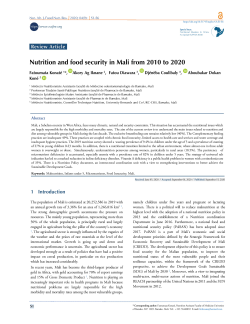Main Article Content
Nutrition and food security in Mali from 2010 to 2020
Abstract
Mali, a Sahelian country in West Africa, faces many climatic, natural and security constraints. This situation has accentuated the nutritional issues which are largely responsible for the high morbidity and mortality rates. The aim of the current review is to understand the main issues related to nutrition and diet among vulnerable groups in Mali during the last decade. The exclusive breastfeeding rate remains relatively low (40%). The Complementary feeding practices are inadequate 49%. These practices are coupled with chronic food insecurity, limited access to health care and services and water coverage and inadequate hygiene practices. The 2019 nutrition survey showed a wasting prevalence of 9.4% in children under the age of 5 and a prevalence of stunting of 27% in young children 0-23 months. In addition, there is a nutritional transition limited to the urban environment, where almost one in three adult women is overweight or obese. Simultaneously, undernutrition perseveres among women, particularly in rural areas (18.5%). The persistence of micronutrient deficiencies is accentuated, especially anemia with a prevalence rate of 82% in children under 5 years. The strategy of universal salt iodization has led to a marked reduction in iodine deficiency disorders. Vitamin A deficiency is a public health problem in women with a retinolemia rate of 35%. There is a Nutrition Policy document, an intersectoral coordination unit with a view to strengthening interventions to better achieve the Sustainable Development Goals.







